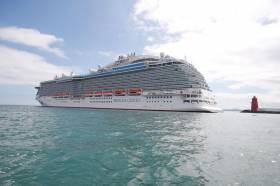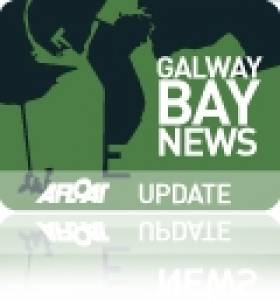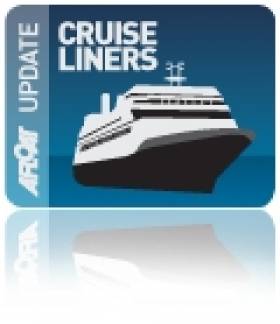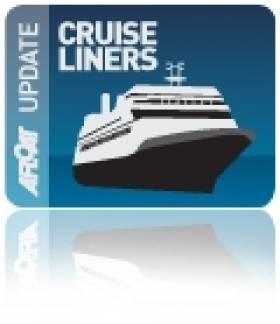Displaying items by tag: Cruiseships
Views of the public, businesses and other interested parties is been sought from Dublin Port Company, on the benefits of investing €108 million in terminal facilities to attract more cruise ships, writes The Irish Times.
The semi-State company (yesterday) launched a public consultation on the future of cruise tourism, seeking opinions on the appetite in the city for his large-scale tourism business, managing the increase in air emissions from additional cruise ships and the financial challenge of funding the proposed new berths.
Economic consultants Indecon estimate the €108 million spent on new berths at the port’s North Wall Quay extension between 2024 and 2026 could generate a net economic benefit of €211 million based on 2019 values.
The port company, however, has said it cannot finance the project itself given its €1 billion plan to build extra capacity to accommodate the projected growth of cargo up to the year 2040.
The proposed new berths would be of limited alternative use outside of cruise ships such as for generating revenue for cargo operations, the company said.
Click here for more on the story.
When cruiseships dock in Cobh they have been warned to keep quiet by the Port of Cork.
The busy port, writes Echolive, which sees up to 100 cruise liners docking throughout the year in the tourist town, has issued a statement regarding noise levels at certain times in an effort to maintain a good relationship with local residents.
In a notice, issued by Captain Paul O’Regan, who is Harbour Master and Chief Operations Officer for the Port of Cork, cruise liner captains were asked to reduce noise pollution in the area.
The notice from Captain O’Regan said that due to the topography of Cobh Cruise Berth, the sound from passenger announcements, music played on external decks and alarm sirens were amplified and this can be an issue for the surrounding residential properties.
To find out the times ship masters must adhere to when using alarms and announcements click here.
Cruiseship Galway Bay Anchorage Call, Larger Ships In Future?
#GalwayHarbour- Prior to Prinsendam's next port of call to Foynes tomorrow, as previously reported, the Dutch flagged cruiseship is today at anchorage off Galway Harbour, writes Jehan Ashmore.
The Holland America Line 38,848grt ship is nearly 1.5 nautical miles offshore in Galway Bay, facing opposite the entrance to Galway Harbour's only single basin, the Dun Aengus Dock.
As reported earlier in the summer, there are plans to build a new larger harbour. Notably, the new outer port would be capable of handling even larger cruiseships than the current anchorage callers. In addition the port wants to bring back the transatlantic callers, reminiscent of the liner era.
This year's Galway Harbour cruise season was opened by the arrival in July of the ultra-luxury and exclusively residential-only vessel, The World which had made an overnight call.
The mid-western port subsequently welcomed the newly launched Le Soreal, the mega-superyacht like cruiseship with a 264-passenger capacity is operated by Companie du Ponant.
Le Soreal is the latest of the three newbuild sisters, L'Austral and Le Boreal which in 2011 visited Dublin Port.
Marking the final cruise caller for the season is Explorer which is due in September. Already lined up so far for the 2014 season is the return of Prinsendam and Crystal Symphony.
"The World" Looks Forward to City of the Tribes
#GALWAY CRUISECALLS –The World, the exclusive ultra-luxury residential passenger ship is to open the 2013 cruise season to Galway Harbour when she is to make a two-night visit during July, writes Jehan Ashmore.
In addition three cruiseships are also to call during the summer months from operators Compagnie du Ponat, Holland America Line and V-Ships. The port in recent years has raised its international profile considerably since the hugely successful hosting of the Volvo Ocean Race twice.
The Norwegian built The World was launched in 2002 and operated by ResidenSea. She is to anchor off Galway Harbour close to Mutton Island. Tenders will transfer passengers ashore as the 43,188 tonnes ship is too large to be accommodated in the single (Dun Aengus) dock.
Her arrival is to generate an economic boost to the city, where the port claim conservatively that 35 cruise liners could call on an annual basis coupled with a visitor spin off of €9.9m.
Galway Port Company Harbour master Captain Brian Sheridan has commented that The World can be accommodated in the proposed new port where the 196m long ship would be able to moor alongside and allow passengers to stroll ashore.
Ports & Shipping Review: New Tallships Race and Cruise Operators, Superpower Naval Visitors, School at Sea, Irish Sea Excursions and Wind-Farms
#PORTS & SHIPPING REVIEW - Over the last fortnight Jehan Ashmore has reported from the Shipping scene where after the Irish Navy's role in the Tallships 'Parade of Sail', the inaugural Irish Sea Tall Ships Race finally got underway to Liverpool.
Also making a call to Dublin Port was cruise newcomer Plantour & Partners's whose small cruiseship Hamburg made her debut visit to the capital port.
The following day saw the classic cruiseship veteran Princess Daphne call, she was launched originally as a general cargo-ship serving the UK-Australia and New Zealand trade routes. In the same week her sister Princess Danae was arrested in Dublin Port, for an alleged non-payment of fuel bills. The dispute was eventually settled which saw the H&W built vessel depart for La Rochelle.
Operating profits at Irish Ferries of €3.2m for the first six months of 2012, remained the same compared to the same period last year, according to its parent company ICG which released its financial interim report.
A special call by the USS Fort McHenry (LSD-43), a dock landing ship to Dublin Port was made to coincide with American Football Week which allowed her crew to attend the Emerald Isle Classic showdown between the Navy and Notre Dame. On a related note US students where making their 'Semester at Sea' cruise on board Explorer which had called to Galway Bay and later the capital.
With the US Navy in Dublin, the rebel county had its own rare visit of the Russian Navy, when the destroyer Vice-Admiral Kulakov (626) called to Cobh. On both occasions the public were able to board.
Glasgow based Waverley Excursions have been running several unusual route excursions out of Northern Ireland. The final excursion was scheduled for today with a day-trip between Portaferry, Co. Down and Peel on the west coast of the Isle of Man.
While on waters off the east coast of the Irish Sea's largest island, proposals for an extended wind-farm will not require re-routing of shipping lanes according to developer Dong Energy. They operate the Walney Island wind-farm off Cumbria.
Ports & Shipping Review: ‘Signature’ Cruiseship, Fishery Detentions, ‘Royal’ Cruiseship, Belfast’s Battleship, Port of Cork Wins Award
#PORTS & SHIPPING REVIEW - Over the last fortnight Jehan Ashmore has reported from the Shipping scene which saw 'signature' cruiseship Mein Schiff 2 with her striking visual livery-scheme calling to Irish ports.
The Naval Service has been made detentions of Irish registered fishing vessels this week and also last month off the Clare and Cork coastlines, bringing to date 12 such incidents so far this year.
The world's smallest 5-star luxury cruiseship Hebridean Princess (1964/2,112grt) which was chartered twice in recent years for the Royal Family, called to Dublin Port recently and is currently on a return cruise from Cork with anchorage calls in Kerry waters.
Dublin Based d'Amico have ordered a pair of 40,000dwt eco-product/chemical tanker vessels, believed to cost US$ 30.65 million, from a South Korean shipyard and delivered early in 2014.
Since her launch in 2010, Cunard Line's newest cruiseship Queen Elizabeth (90,901 tonnes) made her second only visit to Dublin Port, where she called last year and also to Cork, which too was revisited by the 2068 passenger vessel.
The on-going saga to retain the veteran WWI Battle of Jutland survivor HMS Caroline in Belfast, her homeport since 1924 was given a reprieve. The National Museum of the Royal Navy (NMRN) in Portsmouth secured a four-week extension to the original deadline (1 Aug) which was set for scrapping of the historic warship.
The near fifty year-old Hebble Sand (1963/757grt), a grab-hopper dredger which has remained in Dublin Port for more than one year departed Dublin Port and reached Campbeltown last week for new Northern Irish owners Abco Marine.
Port of Cork Company was awarded 'Large Company of the Year for the 2nd Quarter 2012' by the Cork Business Association. This season the port is to welcome 60 cruiseships between April and November, bringing more than 100,000 passengers and crew to the region.
While in Dublin Port, Finnish based Kristina Cruises 400 passenger Kristina Katarena made her inaugural Irish call, the 1982 built vessel was launched from New Szczecin Shipyard. The name of the Polish city may sound familiar as they are the presenting sponsor of Tall Ships Races which are coming to the capital later this month.
#CRUISE LINER SAFETY – Following the Costa Concordia incident off the Italian coast in January, there are to be "tighter" inspections of cruiseships docking in Irish ports according to the State's Marine Survey Office.
Checks on safety and crew handling of "abandon ship" drills and fire-fighting will be stepped up under the office of the Department of Transport. Marine surveyors will also conduct "detailed, additional" checks on whether or not crews are trained and familiar with their vessels, the office says.
Some 30 passengers were confirmed dead and two are still "missing" after the Costa Concordia ran aground and partially sank off Isola del Giglio, Tuscany, on the night of January 13th last.
Calling Cherbourg: All Things Nauting
#FERRY SAILS – Ferry passengers perhaps on a mini-wine break cruise between Rosslare-Cherbourg may be taking a detour to the Cherbourg Nauting Boat Show which is been held this weekend, writes Jehan Ashmore.
Both Celtic Link Ferries and Irish Ferries operate on the continental route to the man-made Norman port originally constructed by Napoleon. The present day bustling town-centre of Cherbourg-Octeville to give its full name is close to the large 1500-plus berth marina at the Port Chantereyne which is hosting the show.
Those attending can buy and sell new and second-hand boats and where there will be exhibitors attending the three-day show which started yesterday. Activities include scuba-diving, dry surf, stand-up-paddle and model-boats on a dedicated pool.
In addition there is a guided-tour on a racing-boat commented by its skipper Eric D'Hooghe from the Figaro Race. Also making an appearance is the French rower Rémy Alnet who will be there to talk about his trans-Atlantic races.
Also on a related note is the La Cité de la Mer which is a museum situated in the former trans-Atlantic liner passenger terminal used during the so called golden era. The history of these liners is recalled in the museum and of course includes the RMS Titanic and the French Line's famous France which as the Norway made a once off anchorage call outside Dun Laoghaire Harbour.
In addition there are displays of submarines including the decomissioned French Navy nuclear-powered submarine Le Redoutable which is located in an adjoining dry-dock.
- Ferry news
- Cherbourg Nauting
- Napoleon Port of Cherbourg
- Port de Cherbourg
- Cite de la Mer
- CherbourgOcteville
- RosslareCherbourg
- Port Chantereyne marina
- Celtic Liink Ferries
- Irish Ferries
- WineBreak Mini Cruises
- Scubadiving
- DrySurfing
- standup paddle
- SUP
- ModelBoats
- New Boats
- SecondHand Boats
- TransAtlantic Liners
- Le Redoutable submarine
- French Navy
- RMS Titanic
- French Line's France
- Cruiseship Norway
- Dun Laoghaire Harbour
- Dun Laoghaire Harbour cruise liner calls
- Dun Laoghaire Harbour Norway anchorage call
- Cruiseships
- Cruiseliners
- Figaro Race
- Eric D'Hooghe
- French rower Remy Alnet
- Remy Alnet
- La Cité de la Mer
Mega-Yacht Cruiseship Returns
#MEGA-YACHTCRUISESHIP – Nearly a year ago to her Irish debut the Le Boréal a mega-yacht cruiseship called to Dublin Port today, writes Jehan Ashmore.
The sleek sweeping lines of the 132 berth and 264 maximum capacity vessel is designed with French flair by Jean-Philippe Nuel and built with Italian expertise by Fincantieri. She is scheduled to depart from the capital tonight. For more information and photographs of the ship, click HERE.
When she entered service for Compagnie du Ponant, the only French cruiseship operator won for the Best New Ship of the Year 2010. The prize was rewarded by the European Cruiser Association for more visit www.eucras.com
Cruiseships Head for Isle of Man
#MANX CRUISE CALLS – The Manx capital is set to welcome over a dozen cruise callers for the season which starts next month according to www.visitisleman.com
Two of the 14 calls that are scheduled to Douglas belong to the Silversea Cruises fleet, the Silver Cloud due in June, has been a fairly frequent visitor to the Isle of Man in the past. While the company's recently acquired 'Expedition' vessel Silver Explorer will be visiting the Island for the first time earlier in May.
Other distinctive inaugural callers in 2012 include the Seven Seas Voyager. The Berlitz Guide rated luxury premium class vessel is also scheduled to visit Douglas again the following year.
In addition to the 2012 season, the Thomson Spirit is due to call in early September, a vessel with a 1,250 passenger capability.
Below is the 2012 cruise call list
Quest for Adventure, 8th May
Arion, 26th May
Discovery, 28th May
Silver Explorer, 31st May
Marco Polo, 4th June
Ocean Countess, 5th June
Seven Seas Voyager, 7th June
Silver Cloud, 8th June
Saga Sapphire, 4th July
Quest for Adventure, 9th July
Marco Polo, 16th July
Deutschland, 20th July
Hebridean Princess, 21st August
Thomson Spirit, 6th September







































































